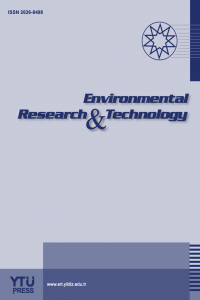Pyrolysis of walnut shell biomass in fluidized bed reactor: Determination of optimum conditions for bio-char production
Pyrolysis of walnut shell biomass in fluidized bed reactor: Determination of optimum conditions for bio-char production
Biomass, Bio-char, Fluidized Bed Reactor Walnut shell, Pyrolysis,
___
- [1] M.S. Masnadi, R. Habibi, J. Kopyscinski, J.M. Hill, X. Bi, C.J. Lim, N. Ellis, J.R Grace, “Fuel characterization and co-pyrolysis kinetics of biomass and fossil fuels,” Fuel, 117, 1204–1214. 2014.
- [2] H. Ly Vu, S.S. Kim, H.C. Woo, J.H. Choi, D.J. Suh, J. Kim, “Fast pyrolysis of macroalga Saccharina japonica in a bubbling fluidized bed reactor for bio-oil production,” Energy, 93, 1436-1446. 2015.
- [3] M. Tripathi, J.N. Sahu, P. G, “Effect of process parameters on production of biochar from biomass waste through pyrolysis: A review,” Renewable and Sustainable Energy Reviews, 55, 467–481. 2016.
- [4] Y.J. Zhang, Z.J. Xing, Z.K. Duan, M. Li, Y. Wang, “Effects of steam activation on the pore structure and surface chemistry of activated carbon derived from bamboo waste”, Appl. Surf. Sci., 315, 279–286, 2014.
- [5] D. Czajczynska, L. Anguilano, H. Ghazal, R. Krzyzynska, A.J. Reynolds, N. Spencer, H. Jouhara, “Potential of pyrolysis processes in the waste management sector”, Thermal Science and Engineering Progress, 3, 171–197, 2017.
- [6] N. Soyler, J. L. Goldfarb, S. Ceylan, M. T. Saçan, “Renewable fuels from pyrolysis of Dunaliella tertiolecta: An alternative approach to biochemical conversions of microalgae,” Energy, 1-8, 2016.
- [7] M. A. Mehmood, G. Ye, H. Luo, C. Liu, S. Malik, I. Afzal, J. Xu, M. S. Ahmad, “Pyrolysis and kinetic analyses of Camel grass (Cymbopogon schoenanthus) for bioenergy,” Bioresorce Technology, 228, 18–24, 2017.
- [8] H. Karatas, F. Akgun, “Experimental results of gasification of walnut shell and pistachio shell in a bubbling fluidized bed gasifier under air and steam atmospheres,” Fuel, 214, 285–292, 2018.
- [9] B. B. Uzun, E. Yaman, “Pyrolysis kinetics of walnut shell and waste polyolefins using thermogravimetric analysis,” Journal of the Energy Institute, 90, 825-837, 2017.
- [10] S. Abhishek, P. Vishnu, Z. Dongke, “Biomass pyrolysis—A review of modelling, process parameters and catalytic studies,” Renewable and Sustainable Energy Reviews, 50, 1081–1096, 2015.
- [11] X. Yuan, Z. Shuai, B. Robert C., K. Atul, B. Xianglan, “Fast pyrolysis of biomass and waste plastic in a fluidized bed reactor,” Fuel, 156, 40-46, 2015.
- [12] W. Hideo, L. Dalin, N. Yoshina, T. Keiichi, K. Kunimitsu, M.W. Makoto, “Characterization of oil-extracted residue biomass of Botryococcus braunii as a biofuel feedstock and its pyrolytic behavior,” Applied Energy, 132, 475-484, 2014.
- Yayın Aralığı: Yılda 4 Sayı
- Başlangıç: 2018
- Yayıncı: Yıldız Teknik Üniversitesi
Removal of Cu (II) from wastewater of metal coating process by borax sludge
Esma Burcu RONA, Meral YİLDİRİM OZEN, Emek MOROYDOR DERUN
Decolorization of Reactive Orange 16 and Reactive Black 5 in aqueous solution by ozonation
İrem ONDER, Okan AYDİN, Afife GUVENC
Adsorption of Remazol Brilliant Blue R by raw and carbonized macroalgal wastes
Anil Tevfik KOCER, Benan INAN, Didem OZCİMEN
Recycling posibilities of packaging wastes - the case of Kırıkkale
Oylum GOKKURT BAKİ, Ozan PARLAK
Life cycle assessment of an office: Carbon footprint of an office staff
